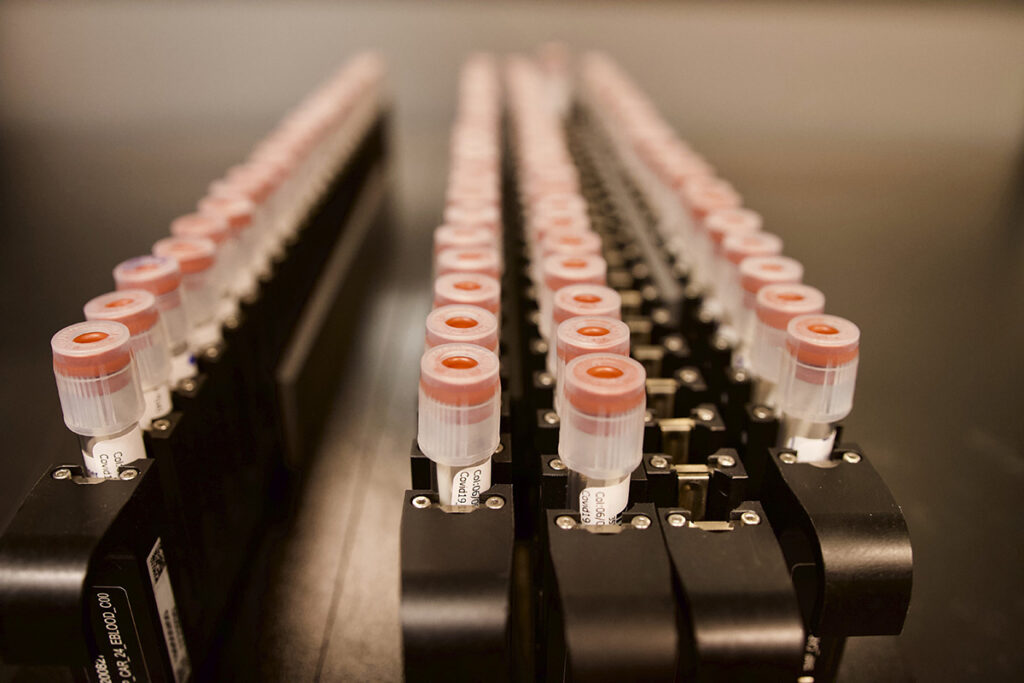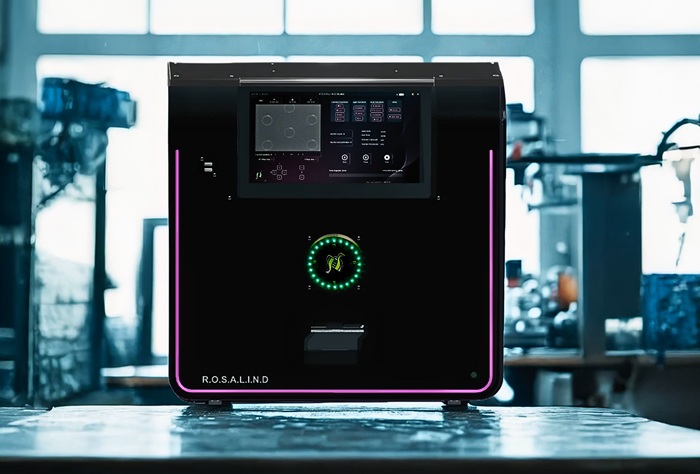New Approach to Pooled COVID-19 Testing Could Be Highly Effective in Curbing SARS-CoV-2 Pandemic
|
By LabMedica International staff writers Posted on 26 Feb 2021 |

Image: COVID-19 tests in a lab at Broad Institute of MIT and Harvard (Photo courtesy of Harvard T.H. Chan School of Public Health)
A new approach to pooled COVID-19 testing can be a highly effective tool for curbing the SARS-CoV-2 pandemic, even if infections are widespread in a community.
Simple pooled testing schemes could be implemented with minimal changes to current testing infrastructures in clinical and public health laboratories, according to researchers at Harvard T.H. Chan School of Public Health (Boston, MA, USA) and the Broad Institute of MIT and Harvard (Cambridge, MA, USA).
By identifying infected individuals so that they can be treated or isolated, SARS-CoV-2 testing is a powerful tool for curbing the COVID-19 pandemic and safely reopening schools and businesses. But limited and sometimes costly testing throughout the pandemic has hampered diagnosing individuals and has hamstrung public health efforts to curtail the virus’s spread. Pooled testing, in which multiple individual samples are processed at once, could be a powerful tool to increase testing efficiency. If a pooled test comes back negative, all samples in that pool are considered negative, thus eliminating the need for further testing. If a pooled sample is positive, the individual samples within that testing group need to be tested again separately to identify which specific samples are positive. Although pooled testing has been implemented during the COVID-19 pandemic, its usefulness is curtailed when the pathogen is widespread in a community. Under those circumstances, most pooled samples could be positive and require additional testing to identify the positive individuals in each pool. This confirmatory testing eliminates any efficiencies gained by pooled testing.
To identify ways to make pooled testing more useful during widespread outbreaks, the researchers developed a model for how quantities of viral RNA - which are used to identify SARS-CoV-2 infection - vary across infected people in the population during an outbreak. This gave the researchers a very detailed picture of how test sensitivity is affected by pool size and SARS-CoV-2 prevalence. They then used the model to identify optimal pooled testing strategies under different scenarios. Using the model, testing efforts could be tailored to the available resources in a community so as to maximize the number of infections identified using as few tests as possible. Even in labs with substantial resource constraints, the team created simple pooled testing schemes that could identify as many as 20 times more infected individuals per day compared with individual testing.
“Our research adds another tool to the testing and public health toolbox,” said Michael Mina, assistant professor of epidemiology at Harvard Chan School and associate member of the Broad. “For public health agencies and clinical laboratories that are performing testing under resource limitations—which for COVID-19 is nearly every nation—this new research demonstrates that we can gain much more testing power for both medical and public health use with the same or even fewer resources than are currently being utilized.”
Related Links:
Harvard T.H. Chan School of Public Health
Broad Institute of MIT and Harvard
Simple pooled testing schemes could be implemented with minimal changes to current testing infrastructures in clinical and public health laboratories, according to researchers at Harvard T.H. Chan School of Public Health (Boston, MA, USA) and the Broad Institute of MIT and Harvard (Cambridge, MA, USA).
By identifying infected individuals so that they can be treated or isolated, SARS-CoV-2 testing is a powerful tool for curbing the COVID-19 pandemic and safely reopening schools and businesses. But limited and sometimes costly testing throughout the pandemic has hampered diagnosing individuals and has hamstrung public health efforts to curtail the virus’s spread. Pooled testing, in which multiple individual samples are processed at once, could be a powerful tool to increase testing efficiency. If a pooled test comes back negative, all samples in that pool are considered negative, thus eliminating the need for further testing. If a pooled sample is positive, the individual samples within that testing group need to be tested again separately to identify which specific samples are positive. Although pooled testing has been implemented during the COVID-19 pandemic, its usefulness is curtailed when the pathogen is widespread in a community. Under those circumstances, most pooled samples could be positive and require additional testing to identify the positive individuals in each pool. This confirmatory testing eliminates any efficiencies gained by pooled testing.
To identify ways to make pooled testing more useful during widespread outbreaks, the researchers developed a model for how quantities of viral RNA - which are used to identify SARS-CoV-2 infection - vary across infected people in the population during an outbreak. This gave the researchers a very detailed picture of how test sensitivity is affected by pool size and SARS-CoV-2 prevalence. They then used the model to identify optimal pooled testing strategies under different scenarios. Using the model, testing efforts could be tailored to the available resources in a community so as to maximize the number of infections identified using as few tests as possible. Even in labs with substantial resource constraints, the team created simple pooled testing schemes that could identify as many as 20 times more infected individuals per day compared with individual testing.
“Our research adds another tool to the testing and public health toolbox,” said Michael Mina, assistant professor of epidemiology at Harvard Chan School and associate member of the Broad. “For public health agencies and clinical laboratories that are performing testing under resource limitations—which for COVID-19 is nearly every nation—this new research demonstrates that we can gain much more testing power for both medical and public health use with the same or even fewer resources than are currently being utilized.”
Related Links:
Harvard T.H. Chan School of Public Health
Broad Institute of MIT and Harvard
Latest COVID-19 News
- New Immunosensor Paves Way to Rapid POC Testing for COVID-19 and Emerging Infectious Diseases
- Long COVID Etiologies Found in Acute Infection Blood Samples
- Novel Device Detects COVID-19 Antibodies in Five Minutes
- CRISPR-Powered COVID-19 Test Detects SARS-CoV-2 in 30 Minutes Using Gene Scissors
- Gut Microbiome Dysbiosis Linked to COVID-19
- Novel SARS CoV-2 Rapid Antigen Test Validated for Diagnostic Accuracy
- New COVID + Flu + R.S.V. Test to Help Prepare for `Tripledemic`
- AI Takes Guesswork Out Of Lateral Flow Testing
- Fastest Ever SARS-CoV-2 Antigen Test Designed for Non-Invasive COVID-19 Testing in Any Setting
- Rapid Antigen Tests Detect Omicron, Delta SARS-CoV-2 Variants
- Health Care Professionals Showed Increased Interest in POC Technologies During Pandemic, Finds Study
- Set Up Reserve Lab Capacity Now for Faster Response to Next Pandemic, Say Researchers
- Blood Test Performed During Initial Infection Predicts Long COVID Risk
- Low-Cost COVID-19 Testing Platform Combines Sensitivity of PCR and Speed of Antigen Tests
- Finger-Prick Blood Test Identifies Immunity to COVID-19
- Quick Test Kit Determines Immunity Against COVID-19 and Its Variants
Channels
Clinical Chemistry
view channel
Noninvasive Blood-Glucose Monitoring to Replace Finger Pricks for Diabetics
People with diabetes often need to measure their blood glucose multiple times a day, most commonly through finger-prick blood tests or implanted sensors. These methods can be painful, inconvenient, and... Read more
POC Breath Diagnostic System to Detect Pneumonia-Causing Pathogens
Pseudomonas aeruginosa is a major cause of hospital-acquired and ventilator-associated pneumonia, particularly in lung transplant recipients and patients with structural lung disease. Its ability to form... Read moreMolecular Diagnostics
view channel
World's First NGS-Based Diagnostic Platform Fully Automates Sample-To-Result Process Within Single Device
Rapid point-of-need diagnostics are of critical need, especially in the areas of infectious disease and cancer testing and monitoring. Now, a direct-from-specimen platform that performs genomic analysis... Read more
Rapid Diagnostic Breakthrough Simultaneously Detects Resistance and Virulence in Klebsiella Pneumoniae
Antibiotic resistance is a steadily escalating threat to global healthcare, making common infections harder to treat and increasing the risk of severe complications. One of the most concerning pathogens... Read moreHematology
view channel
MRD Tests Could Predict Survival in Leukemia Patients
Acute myeloid leukemia is an aggressive blood cancer that disrupts normal blood cell production and often relapses even after intensive treatment. Clinicians currently lack early, reliable markers to predict... Read more
Platelet Activity Blood Test in Middle Age Could Identify Early Alzheimer’s Risk
Early detection of Alzheimer’s disease remains one of the biggest unmet needs in neurology, particularly because the biological changes underlying the disorder begin decades before memory symptoms appear.... Read more
Microvesicles Measurement Could Detect Vascular Injury in Sickle Cell Disease Patients
Assessing disease severity in sickle cell disease (SCD) remains challenging, especially when trying to predict hemolysis, vascular injury, and risk of complications such as vaso-occlusive crises.... Read more
ADLM’s New Coagulation Testing Guidance to Improve Care for Patients on Blood Thinners
Direct oral anticoagulants (DOACs) are one of the most common types of blood thinners. Patients take them to prevent a host of complications that could arise from blood clotting, including stroke, deep... Read moreImmunology
view channel
Blood Test Could Identify Colon Cancer Patients to Benefit from NSAIDs
Colon cancer remains a major cause of cancer-related illness, with many patients facing relapse even after surgery and chemotherapy. Up to 40% of people with stage III disease experience recurrence, highlighting... Read moreBlood Test Could Detect Adverse Immunotherapy Effects
Immune checkpoint inhibitors have transformed cancer treatment, but they can also trigger serious immune-related adverse events that damage healthy organs and may become life-threatening if not detected early.... Read moreMicrobiology
view channel
New UTI Diagnosis Method Delivers Antibiotic Resistance Results 24 Hours Earlier
Urinary tract infections affect around 152 million people every year, making them one of the most common bacterial infections worldwide. In routine medical practice, diagnosis often relies on rapid urine... Read more
Breakthroughs in Microbial Analysis to Enhance Disease Prediction
Microorganisms shape human health, ecosystems, and the planet’s climate, yet identifying them and understanding how they are related remains a major scientific challenge. Even with modern DNA sequencing,... Read morePathology
view channel
AI Tool Simultaneously Identifies Genetic Mutations and Disease Type
Interpreting genetic test results remains a major challenge in modern medicine, particularly for rare and complex diseases. While existing tools can indicate whether a genetic mutation is harmful, they... Read more
Rapid Low-Cost Tests Can Prevent Child Deaths from Contaminated Medicinal Syrups
Medicinal syrups contaminated with toxic chemicals have caused the deaths of hundreds of children worldwide, exposing a critical gap in how these products are tested before reaching patients.... Read more
Tumor Signals in Saliva and Blood Enable Non-Invasive Monitoring of Head and Neck Cancer
Head and neck cancers are among the most aggressive malignancies worldwide, with nearly 900,000 new cases diagnosed each year. Monitoring these cancers for recurrence or relapse typically relies on tissue... Read moreTechnology
view channel
Diagnostic Chip Monitors Chemotherapy Effectiveness for Brain Cancer
Glioblastoma is one of the most aggressive and fatal brain cancers, with most patients surviving less than two years after diagnosis. Treatment is particularly challenging because the tumor infiltrates... Read more
Machine Learning Models Diagnose ALS Earlier Through Blood Biomarkers
Amyotrophic lateral sclerosis (ALS) is a rapidly progressive neurodegenerative disease that is notoriously difficult to diagnose in its early stages. Early symptoms often overlap with other neurological... Read moreIndustry
view channel
BD and Penn Institute Collaborate to Advance Immunotherapy through Flow Cytometry
BD (Becton, Dickinson and Company, Franklin Lakes, NJ, USA) has entered into a strategic collaboration with the Institute for Immunology and Immune Health (I3H, Philadelphia, PA, USA) at the University... Read more

























